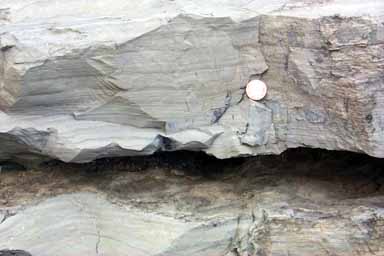|
DOLOMITE #1 Algal Laminated Dolomite Go on to: #1 | #2 | #3 | #4  Detail of this specimen
Detail of this specimen>>> Return to previous
Return to: Alphabetical Listing Basic Key Carbonate Key |
||
|
Composition
Dolomite/dolostone = CaMg(CO3)2. Rock probably began as a calcitic rock (CaCO3) (an algal laminated micrite), but was converted to dolomite after formation.
|
Description
Dense, uniform, fine grained rock with conchoidal fracture. Faint, weak laminations running parallel to bedding. The laminations are probably algal laminates, produced on tidal flats by colonies of blue-green algae.
|
|
|
Tectonic Association
Carbonates of all types are commonly associated with regions of tectonic stability and tropical climates, that is no mountain building, and stable, shallow water environments associated with continental shelves or epeiric (epicontinental) seas.Go to Carbonate Tectonics for more explanation. |
Formation & Environments
There is a lot of controversy about the origin of dolomite. Most of it is probably of secondary origin from the recrystallization of limestone by the substitution of magnesium atoms for calcium atoms in the crystal structure. This rock is likely a recrystallized algal laminated micrite. See Origin of Dolomite for more information. One way or another, dolomitic rocks are formed in many of the environments limestones form in - just depending on the limestone. This particular exposure is algal laminated, and found with other evidence of tidal flat feature. It most likely formed in the upper intertidal to supertidal region. |
|